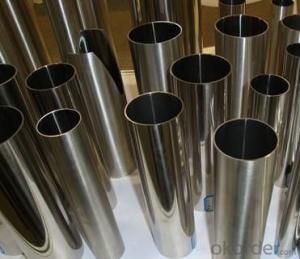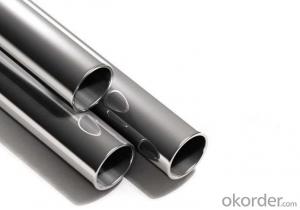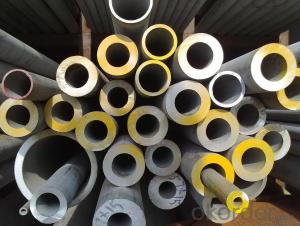201 304 2B Stainless Steel Pipes
- Loading Port:
- China main port
- Payment Terms:
- TT OR LC
- Min Order Qty:
- 5 m.t.
- Supply Capability:
- 100000 m.t./month
OKorder Service Pledge
Quality Product, Order Online Tracking, Timely Delivery
OKorder Financial Service
Credit Rating, Credit Services, Credit Purchasing
You Might Also Like
Item specifice
Standard:
AISI,JIS,GB,BS,DIN,API,EN,ASTM
Technique:
Hot Rolled,Cold Rolled,Cold Drawn,ERW,Forged,Saw,Extruded,EFW,Spring
Shape:
U Channel,Square,C Channel,Hexagonal,Round,Rectangular,Oval,LTZ
Surface Treatment:
Galvanized,Coated,Copper Coated,Color Coated,Oiled,Dry,Chromed Passivation,Polished,Bright,Black,PVDF Coated
Steel Grade:
Q195,Q215,Q235,Q215B,Q235B,RHB335,HRB400,200 Series,300 Series,400 Series,600 Series,SS400-SS490,10#,20#,A53(A,B)
Certification:
ISO,SGS,CE
Thickness:
as required
Length:
12m
Net Weight:
as required

201 304 2B Stainless Steel Pipes
Specifications
Description: 301 304 410 430 stainless steel pipes with ASTM JIN standard
Material: 200#, 240#,320#,500#,600#, etc.
Outside Diameter: 9mm~216mm
Wall thickness: 0.3 mm ~ 3.0 mm
Length: as your requirement
Application: best selling stainless steel pipes applies to petroleum, chemical industry, electric power, boiler, high temperature resistan
Technique: cold rolled
Standard: AISI, ASTM, GB, JIS
Products Show
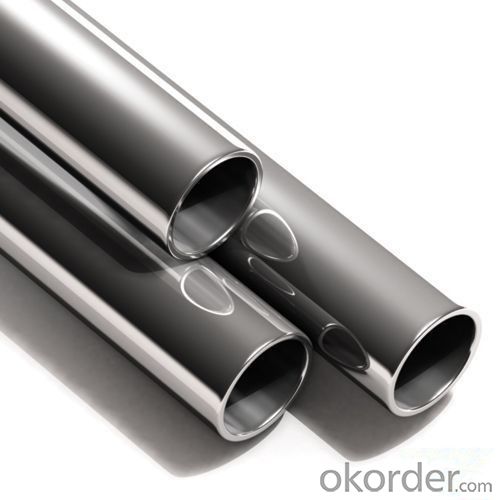

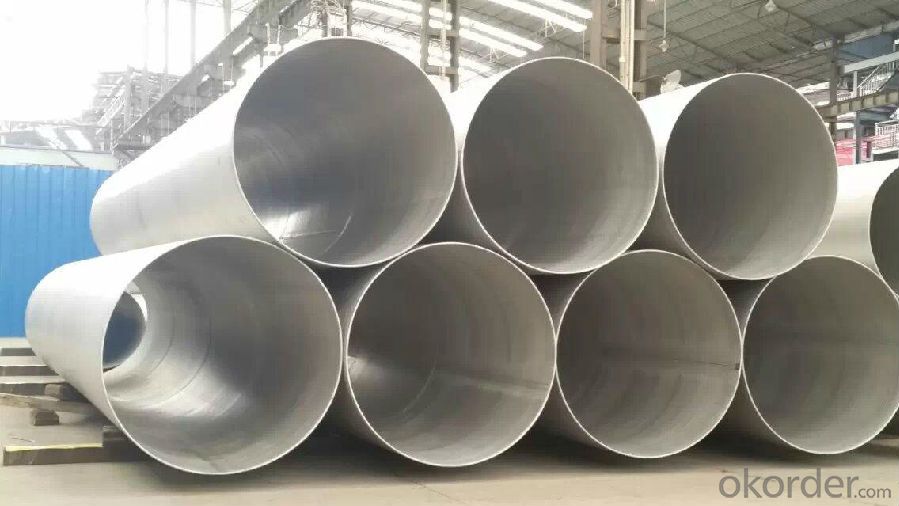
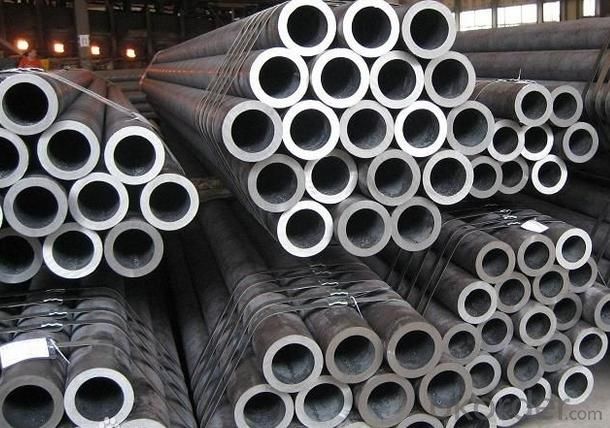
- Q:Are stainless steel pipes suitable for food processing applications?
- Yes, stainless steel pipes are highly suitable for food processing applications. This is because stainless steel is resistant to corrosion, easy to clean and sanitize, and does not react with food or alter its taste. Additionally, stainless steel pipes comply with hygiene and safety standards, making them ideal for the food industry.
- Q:How do you protect stainless steel pipes from external damage?
- To protect stainless steel pipes from external damage, there are several measures you can take: 1. Apply a protective coating: Using a protective coating such as paint or epoxy can help shield the stainless steel pipes from moisture, chemicals, and physical damage. The coating should be selected based on the specific environment and potential risks to ensure maximum protection. 2. Install pipe supports: Properly installing pipe supports can prevent excessive movement and vibration, which can lead to damage over time. Using brackets, clamps, or hangers to secure the pipes in place will minimize the risk of external impacts causing harm. 3. Implement corrosion prevention measures: Stainless steel pipes are resistant to corrosion, but in certain environments, they can still be susceptible to damage. Regularly inspect the pipes for signs of corrosion and promptly address any issues. Applying corrosion inhibitors or using cathodic protection techniques can also help safeguard the pipes from external damage. 4. Use protective guards or covers: In areas where the pipes are exposed to potential impact or physical damage, installing protective guards or covers can provide an additional layer of protection. These guards can be made of materials such as plastic or rubber and can be easily installed or removed as needed. 5. Implement proper handling and storage procedures: During transportation or storage, it is essential to handle stainless steel pipes with care. Avoid dropping or dragging them and ensure they are stored in a clean, dry, and well-ventilated area to prevent moisture buildup and potential damage. By following these measures, you can effectively protect stainless steel pipes from external damage, prolonging their lifespan and ensuring their functionality.
- Q:Can stainless steel pipes be bent or shaped?
- Stainless steel pipes possess the capability to undergo bending or shaping. Their favorable ductility allows for easy transformation into various shapes and configurations. Specialized equipment, including pipe bending machines or hydraulic presses, are commonly utilized to achieve this. By applying pressure at specific points, these tools induce the desired bend or formation in the pipe. The extent of bending or shaping depends on factors such as the pipe's diameter, thickness, and the desired angle or curvature. It is crucial to exercise caution during the bending process to prevent any harm or distortion to the stainless steel pipe.
- Q:What is the significance of the schedule in stainless steel pipes?
- The thickness of the pipe walls is what the schedule in stainless steel pipes refers to. It plays a crucial role in determining the pipe's strength, durability, and ability to handle pressure. The schedule is represented by a numerical value, such as Schedule 10, Schedule 40, or Schedule 80, which indicates the thickness of the pipe. The schedule's importance lies in its impact on the pipe's ability to withstand different conditions and applications. A higher schedule number means a thicker wall, resulting in increased strength and resistance to both internal and external pressures. This makes stainless steel pipes with a higher schedule suitable for applications that involve high pressure and high temperature, such as industrial processes, oil and gas pipelines, and chemical processing plants. Additionally, the schedule also affects the flow capacity of the pipe. Thicker-walled pipes have a smaller internal diameter, which reduces the flow rate compared to pipes with thinner walls. This factor is crucial when considering the fluid flow requirements in plumbing systems, HVAC installations, and other applications. The choice of the appropriate schedule for stainless steel pipes depends on specific project requirements, including pressure, temperature, and flow conditions. It is essential to select the correct schedule to ensure the pipe can safely and efficiently handle the intended application. To summarize, the significance of the schedule in stainless steel pipes lies in its influence on strength, pressure handling capabilities, and flow capacity. By understanding the schedule, engineers and professionals can make informed decisions when selecting and installing stainless steel pipes for various industrial, commercial, and residential applications.
- Q:How long do stainless steel pipes last?
- Stainless steel pipes have an impressive lifespan and can last for several decades, depending on various factors such as the quality of the steel, installation techniques, and maintenance practices. In general, with proper care and maintenance, stainless steel pipes can last 50 years or more.
- Q:Stainless steel pipes can not be less than the amount of chromium
- 304 stainless steel tube as 304 steel pipe, in the dry clean atmosphere, have absolutely excellent anti-corrosion ability, but it will be moved to the beach area, with large amounts of sea salt fog, will rust quickly; and the good performance of 316 steel pipe. Therefore, it is not any kind of stainless steel, capable of corrosion and rust in any environment. Stainless steel is a very thin layer formed on the surface and the stability of the fine solid chromium rich oxide film (protective film), to prevent the infiltration of oxygen atoms, to oxidation, and the ability to obtain anti-corrosion. Once there are some reasons, this film was constantly destroyed, air or liquid oxygen atoms will continue to infiltrate or metal atoms of iron to keep out from the loose formation of iron oxide, the metal surface will be continuously corroded. Many of the surface damage form, more common in daily life are as follows: 1. stainless steel surface deposited dust or heterogeneous metal particles containing other metal elements of the attachment, in the humid air, condensed water and adhesion between the stainless steel, the two together into a micro battery, cause the electrochemical reaction, the film has been destroyed, called electrochemical corrosion. 2. stainless steel surface adhesion of organic juice (such as vegetables, soup, sputum), oxygen in the water under the circumstances, a long time, organic acid, organic acid on the surface of metal corrosion. 3., stainless steel surface adhesion contains acid, alkali and salt substances (such as decoration wall caustic soda, lime water splash), causing local corrosion. 4., in polluted air (such as containing large amounts of sulfide, carbon dioxide and nitrogen oxides in the atmosphere), in case of condensation water, the formation of sulfuric acid, nitric acid, acetic acid liquid point, causing chemical corrosion.
- Q:Can stainless steel pipes be used for geothermal heating systems?
- Yes, stainless steel pipes can be used for geothermal heating systems. Stainless steel is highly resistant to corrosion, making it suitable for the harsh underground environment of geothermal systems. It also has excellent thermal conductivity, allowing for efficient heat transfer.
- Q:Can stainless steel pipes be used for exhaust systems?
- Yes, stainless steel pipes can be used for exhaust systems. They are commonly used due to their excellent corrosion resistance, high temperature tolerance, and durability. Stainless steel pipes can withstand the harsh conditions of exhaust gases and provide a long-lasting and efficient solution for exhaust systems.
- Q:How do you calculate the pipe length required for a specific application?
- To calculate the pipe length required for a specific application, you need to consider factors such as the flow rate, pressure drop, pipe material, and the type of fluid being transported. By using equations and formulas specific to fluid dynamics, you can determine the appropriate pipe length needed to achieve the desired flow and pressure conditions. Additionally, factors like pipe fittings, bends, and elbows also need to be taken into account when calculating the overall pipe length required.
- Q:What is the difference between 17-4 and 15-5 stainless steel pipes?
- The main difference between 17-4 and 15-5 stainless steel pipes lies in their chemical compositions and resulting mechanical properties. 17-4 stainless steel contains approximately 17% chromium and 4% nickel, while 15-5 stainless steel contains about 15% chromium and 5% nickel. As a result, 17-4 stainless steel has higher levels of both chromium and nickel, providing better corrosion resistance and improved strength compared to 15-5 stainless steel. However, 15-5 stainless steel offers superior toughness and ease of welding. Ultimately, the choice between these two types of stainless steel pipes depends on the specific requirements of the application and the desired balance between corrosion resistance, strength, and weldability.
1. Manufacturer Overview |
|
|---|---|
| Location | |
| Year Established | |
| Annual Output Value | |
| Main Markets | |
| Company Certifications | |
2. Manufacturer Certificates |
|
|---|---|
| a) Certification Name | |
| Range | |
| Reference | |
| Validity Period | |
3. Manufacturer Capability |
|
|---|---|
| a)Trade Capacity | |
| Nearest Port | |
| Export Percentage | |
| No.of Employees in Trade Department | |
| Language Spoken: | |
| b)Factory Information | |
| Factory Size: | |
| No. of Production Lines | |
| Contract Manufacturing | |
| Product Price Range | |
Send your message to us
201 304 2B Stainless Steel Pipes
- Loading Port:
- China main port
- Payment Terms:
- TT OR LC
- Min Order Qty:
- 5 m.t.
- Supply Capability:
- 100000 m.t./month
OKorder Service Pledge
Quality Product, Order Online Tracking, Timely Delivery
OKorder Financial Service
Credit Rating, Credit Services, Credit Purchasing
Similar products
New products
Hot products
Related keywords
